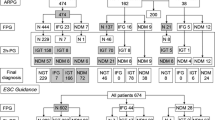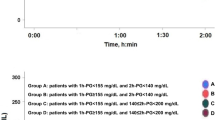Abstract
The aim of this study was to characterize the abnormalities in glucose homeostasis in intensive care unit patients following an acute coronary event. The study population included all non-diabetic patients ages 20–80 years that were admitted to a coronary intensive unit. Glucose, insulin and C-peptide levels during an oral glucose tolerance test (OGTT) were measured during the acute admission. From January to September 2003, 277 patients were admitted to the coronary unit. Of these, 127 patients underwent an OGTT. Of these, only 29 patients (23%) exhibited normal glucose metabolism. The remainder had type 2 diabetes (32%), impaired glucose tolerance (37%) or isolated impaired fasting glucose (8%, 100–125 mg/dl). Based on homeostasis model assessment (HOMA) calculations, diabetic patients had impaired β-cell function and patients with elevated fasting glucose levels were insulin resistant. Beta-cell dysfunction during the acute stress seems to contribute to the glucose abnormalities. Most patients who experience an acute coronary event demonstrate abnormal glucose metabolism. Post glucose-load abnormalities are more common than abnormal fasting glucose level in this situation. It is postulated that the acute stress of a coronary event may contribute to the dysglycemia.

Similar content being viewed by others
References
Gerstein HC (1998) Dysglycaemia: a cardiovascular risk factor. Diabetes Res Clin Pract 40(suppl):S9–S14
Haffner SM (1998) The importance of hyperglycemia in the nonfasting state to the development of cardiovascular disease. Endocr Rev 19:583–592
Tai ES, Goh SY, Lee JJM, Wong MS, Heng D, Hughes K, Chew SK, Cutter J, Chew W, Gu K, Chia KS, Tan CE (2004) Lowering the criterion for impaired fasting glucose: impact on disease prevalence and associated risk of diabetes and ischemic heart disease. Diabetes Care 27:1728–1734
Tominaga M, Eguchi H, Manaka H, Igarashi K, Kato T, Sekikawa A (1999) Impaired glucose tolerance is a risk factor for cardiovascular disease, but not impaired fasting glucose: the Funagata diabetes study. Diabetes Care 22:920–924
Choi KM, Lee KW, Kim SG, Kim NH, Park CG, Seo HS, Oh DJ, Choi DS, Baik SH (2005) Inflammation, insulin resistance, and glucose intolerance in acute myocardial infarction patients without a previous diagnosis of diabetes mellitus. J Clin Endocrinol Metab 90:175–180
Norhammar A, Tenerz Å, Nilsson G, Hamsten A, Efendíc S, Rydén L, Malmberg K (2002) Glucose metabolism in patients with acute myocardial infarction and no previous diagnosis of diabetes mellitus: a prospective study. Lancet 359:2140–2144
Ramachandran A, Chamukuttan S, Immaneni S, Shanmugam RM, Vishnu N, Viswanathan V, Jaakko T (2005) High incidence of glucose intolerance in Asian-Indian subjects with acute coronary syndrome. Diabetes Care 28:2492–2496
Avignon A, Boegner C, Mariano-Goulart D, Colette C, Monnier L (1999) Assessment of insulin sensitivity from plasma insulin and glucose in the fasting or post oral glucose-load state. Int J Obes 23:512–517
Unwin N, Shaw J, Zimmet P, Alberti KGMM (2002) Impaired glucose tolerance and impaired fasting glycaemia: the current status on definition and intervention. Diabet Med 19:708–723
The expert committee on the diagnosis, classification of diabetes mellitus (2003) Follow-up report on the diagnosis of diabetes mellitus. Diabetes Care 26:3160–3167
Kuhl J, Hilding A, Östenson CG, Grill V, Efendic S, Båvenholm P (2005) Characterisation of subjects with early abnormalities of glucose tolerance in the stockholm diabetes prevention programme: the impact of sex and type 2 diabetes heredity. Diabetologia 48:35–40
Abdul-Ghani MA, Jenkinson CP, Richardson DK, Tripathy D, DeFronzo RA (2006) Insulin secretion and action in subjects with impaired fasting glucose and impaired glucose tolerance: results from the veterans administration genetic epidemiology study. Diabetes 55:1430–1435
Festa A, D’Agostino R Jr, Hanley AJG, Karter AJ, Saad MF, Haffner SM (2004) Differences in insulin resistance in nondiabetic subjects with isolated impaired glucose tolerance or isolated impaired fasting glucose. Diabetes 53:1549–1555
Hanefeld M, Koehler C, Fuecker K, Henkel E, Schaper F, Temelkova-Kurktschiev T (2003) Insulin secretion and insulin sensitivity pattern is different in isolated impaired glucose tolerance and impaired fasting glucose: the risk factor in impaired glucose tolerance for atherosclerosis and diabetes study. Diabetes Care 26:868–874
Hsieh CH, Kuo SW, Hung YJ, Shen DC, Ho CT, Lian WC, Lee CH, Fan SC, Pei D (2005) Metabolic characteristics in individuals with impaired glucose homeostasis. Int J Clin Pract 59:639–644
The DECODE Study Group (2003) Age- and sex-specific prevalences of diabetes and impaired glucose regulation in 13 European cohorts. Diabetes Care 26:61–69
Hanley AJG, Williams K, Stern MP, Haffner SM (2002) Homeostasis model assessment of insulin resistance in relation to the incidence of cardiovascular disease: the san antonio heart study. Diabetes Care 25:1177–1184
Abdul-Ghani MA, Tripathy D, DeFronzo RA (2006) Contributions of beta-cell dysfunction and insulin resistance to the pathogenesis of impaired glucose tolerance and impaired fasting glucose. Diabetes Care 29:1130–1139
Monnier L, Lapinski H, Colette C (2003) Contributions of fasting and postprandial plasma glucose increments to the overall diurnal hyperglycemia of type 2 diabetic patients: variations with increasing levels of HbA1c. Diabetes Care 26:881–885
Welin L, Bresäter LE, Eriksson H, Hansson PO, Welin C, Rosengren A (2003) Insulin resistance and other risk factors for coronary heart disease in elderly men: the study of men born in 1913 and 1923. Eur J Cardiovasc Prevention Rehab 10:283–288
Rewers M, Zaccaro D, D’Agostino R, Haffner S, Saad MF, Selby JV, Bergman R, Savage P (2004) Insulin sensitivity, insulinemia, and coronary artery disease: the insulin resistance atherosclerosis study. Diabetes Care 27:781–787
Despres JP, Lamarche B, Mauriege P, Cantin B, Dagenais GR, Moorjani S, Lupien PJ (1996) Hyperinsulinemia as an independent risk factor for ischemic heart disease. N Engl J Med 334:952–957
Cavalot F, Petrelli A, Traversa M, Bonomo K, Fiora E, Conti M, Anfossi G, Costa G, Trovati M (2006) Postprandial blood glucose is a stronger predictor of cardiovascular events than fasting blood glucose in type 2 diabetes mellitus, particularly in women: lessons from the San Luigi Gonzaga diabetes study. J Clin Endocrinol Metab 91:813–819
Chiasson JL, Josse RG, Gomis R, Hanefeld M, Karasik A, Laakso M (2003) Acarbose treatment and the risk of cardiovascular disease and hypertension in patients with impaired glucose tolerance: the STOP-NIDDM trial. JAMA 290:486–494
Hanefeld M, Cagatay M, Petrowitsch T, Neuser D, Petzinna D, Rupp M (2004) Acarbose reduces the risk for myocardial infarction in type 2 diabetic patients: meta-analysis of seven long-term studies. Eur Heart J 25:10–16
UK Prospective Diabetes Study Group (1998) Intensive blood-glucose control with sulphonylureas or insulin compared with conventional treatment and risk of complications in patients with type 2 diabetes (UKPDS 33). Lancet 352:837–853
Bock G, Man CD, Campioni M, Chittilapilly E, Basu R, Toffolo G, Cobelli C, Rizza R (2006) Pathogenesis of pre-diabetes: mechanisms of fasting and postprandial hyperglycemia in people with impaired fasting glucose and/or impaired glucose tolerance. Diabetes 55:3536–3549
Hu FB, Stampfer MJ, Haffner SM, Solomon CG, Willett WC, Manson JE (2002) Elevated risk of cardiovascular disease prior to clinical diagnosis of type 2 diabetes. Diabetes Care 25:1129–1134
Tenerz Å, Norhammar A, Silveira A, Hamsten A, Nilsson G, Rydén L, Malmberg K (2003) Diabetes, insulin resistance, and the metabolic syndrome in patients with acute myocardial infarction without previously known diabetes. Diabetes Care 26:2770–2776
Bartnik M, Rydén L, Ferrari R, Malmberg K, Pyörälä K, Simoons M, Standl E, Soler-Soler J, Öhrvik J (2004) The prevalence of abnormal glucose regulation in patients with coronary artery disease across Europe: the Euro heart survey on diabetes and the heart. Eur Heart J 25:1880–1890
Rathmann W, Icks A, Haastert B, Giani G, Lowel H, Mielck A (2002) Undiagnosed diabetes mellitus among patients with prior myocardial infarction. Z Kardiol 91:620–625
Shiloah E, Witz S, Abramovitch Y, Cohen O, Buchs A, Ramot Y, Weiss M, Unger A, Rapoport MJ (2003) Effect of acute psychotic stress in nondiabetic subjects on beta-cell function and insulin sensitivity. Diabetes Care 26:1462–1467
Wallander M, Bartnik M, Efendic S, Hamsten A, Malmberg K, Ohrvik J, Ryden L, Silveira A, Norhammar A (2005) Beta cell dysfunction in patients with acute myocardial infarction but without previously known type 2 diabetes: a report from the GAMI study. Diabetologia 48:2229–2235
Acknowledgments
This study was supported by a grant from the Israeli Association for the Study of Diabetes. The authors wish to thank the nursing staff of the ICCU for their help in this work, and Dr. Aubrey Stoch for his help in preparing the manuscript.
Conflict of interest statement
None.
Author information
Authors and Affiliations
Corresponding author
Rights and permissions
About this article
Cite this article
Ilany, J., Marai, I., Cohen, O. et al. Glucose homeostasis abnormalities in cardiac intensive care unit patients. Acta Diabetol 46, 209–216 (2009). https://doi.org/10.1007/s00592-008-0077-0
Received:
Accepted:
Published:
Issue Date:
DOI: https://doi.org/10.1007/s00592-008-0077-0




